Low-carbon technologies moving from concept to reality at the rig site
Industry continues to develop new ways to reduce emissions, not only through engines but also drilling waste, hydraulic ring line
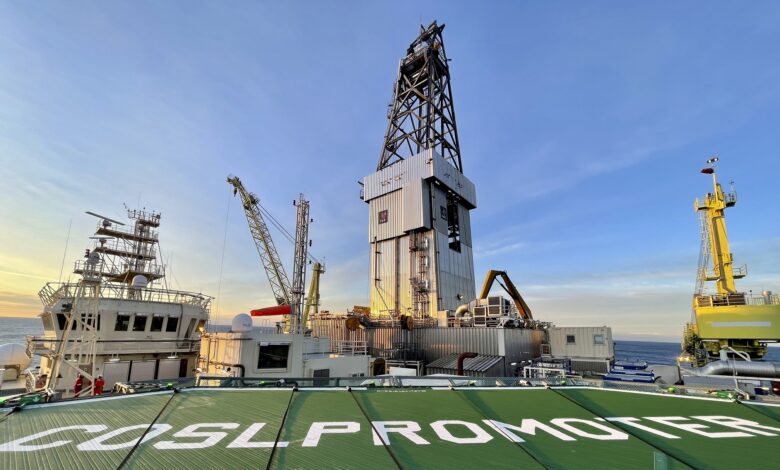
By Stephen Whitfield, Associate Editor
The oil and gas industry is well aware of the need to adapt to a low-carbon future. With the push for net-zero growing more urgent in recent years, the industry is moving beyond discussing the need for sustainable solutions and toward the delivery of effective technologies that reduce or eliminate harmful emissions from drilling operations.
“We’ve seen a big step-change,” said Frank Tollefsen, CEO of COSL Drilling Europe. “Everybody in our industry recognizes that we need to operate as sustainably as possible, but there’s been an increased focus and an increase in pressure from the regulators, from investors and from the public. It’s ever growing, and it only emphasizes the importance of us delivering sustainable solutions if we want to be part of the energy mix.”
Many of the low-carbon technologies currently available focus on reducing Scope 1 emissions, or the emissions that come from sources directly owned by an organization. Engine management systems are the main focus of development in this area. A number of drilling contractors have recently launched systems designed to improve fuel efficiency by reducing the number of active engines on their rigs. Further, new technologies in the market are focused on minimizing the impact of peripheral emitters in a drilling operation, such as the hydraulic ring line or the transport and treatment of drill cuttings waste.
Regardless of the system, the priority for drilling contractors and manufacturers is getting support from customers for wide-scale adoption, which can be difficult in an industry that’s typically been slow to accept new technologies. The key to achieving that adoption is demonstrating their capabilities in the field and showing companies the value they can provide.
“We’ve had to establish the reliability of these solutions operationally so that you can get more buy-in,” said Gilles Luca, Senior Vice President and Chief Operating Officer at Valaris. “You want to adopt a conservative approach, and that includes carefully bringing in your rig crews and your operators on the journey, and demonstrating to them the sound operational and engineering basis of these solutions. The best thing to move this forward is to move slowly but surely, and build a successful operational track record with these technologies, so that people will have the confidence and willingness to use them.”
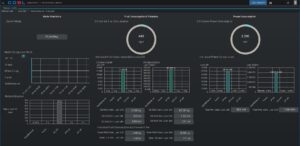
Energy Control System
In 2020, after six years of development, COSL Drilling Europe launched its Energy Control Project, designed to save energy on COSL rigs operating in the Norwegian North Sea. The project is primarily centered on reducing fuel usage of engines and generators on COSL rigs and, subsequently, reducing greenhouse gas (GHG) emissions.
The main deliverable from the Energy Control Project is the Energy Control System, an automated software program that monitors power consumption during a given operation. The system advises users on the courses of action likely to require the least amount of power consumption, estimating the kilowatts needed, the amount of fuel needed and the subsequent CO2 and NOx emissions. These estimates are displayed on a dashboard that users can access from anywhere.
The system is connected to the rig’s control system so it can act upon its advisory without any input from the rig crew. However, it also has manual override capabilities for unforeseen circumstances, like a weather event where users may need to shut down more generators than expected.
Torfinn Kalstø, ICT & OT Manager at COSL Drilling Europe, said the monitoring and advisory capabilities in the Energy Control System provide essential insights and help maximize efficiency gains from the rig. “We’re looking to produce the most efficient kilowatt hours from the generator. This is the whole idea. It’s all about maintaining high performance and, at the same time, lowering the power usage.”
In 2020, COSL Drilling installed the Energy Control System on two semisubmersibles in the North Sea – the COSL Promoter, working for Equinor on the Troll field, and COSL Innovator, working for Chrysaor. The rigs are each powered by six diesel generators with maximum capacities of 4,800kW. These previously ran continuously during drilling operations, but pre-installation analysis showed these generators were rarely used at full capacity.
Running the Energy Control software, COSL Drilling found that it could shut down, on average, four of the six diesel engines during operations.
The company has already seen a significant reduction in fuel consumption on these rigs. Prior to installation, the rigs averaged 27 tons/day of fuel consumed in Posmoor/ATA mode (where the rig is running a thruster-assisted mooring control system) and 29 tons/day in full DP3 mode. After installation, COSL Drilling now sees averages of 14/tons day in Posmoor/ATA mode and 20 tons/day in DP3 mode. Depending on the operation, the company has reported fuel consumption as low as 7.6 tons/day. CO2 and NOx emissions have also fallen by around 50% on the two rigs since installation.
“We were almost shocked to see how much energy we were consuming in normal drilling operations,” Mr Tollefsen said. “Even when we first developed this, we thought we would need all of this energy, but in a normal drilling operation, the actual requirements can fall so low that they’re well within the capacity of one generator. On average, we can run two or three, but sometimes we’re down to one generator. That’s almost unheard of in the industry because you always assume you need some additional reserves.”
COSL Drilling also installed the system on the COSL Pioneer, operating on the UK Continental Shelf, in December 2021. In the three months following installation, the semisubmersible saved 904 tons of fuel compared with the previous three months. This fuel reduction equated to approximately 2.85 tons of CO2 saved.
The Energy Control System is currently running on all three of COSL Drilling’s contracted rigs in the North Sea. In March 2022, the COSL Pioneer began work under a new contract with Ithaca Energy that is expected to last until Q2 2024. The COSL Promoter is slated to work for Equinor through Q1 2024, while the COSL Innovator began a new contract with CNOOC Europe in April 2022.
While the Energy Control System was developed for use on COSL Drilling’s North Sea rigs, Mr Tollefsen said the company is looking to expand its deployment in other regions, as well.
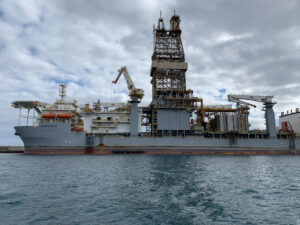
Engine management
Valaris is looking to enhanced power management systems as a low-carbon offering in its technology portfolio. In October 2021, the VALARIS DS-12 drillship became the first vessel in the world to receive the ABS Enhanced Electrical System Notation EHS-E. Valaris upgraded the rig’s electrical system to secure the notation, which recognizes improvements in power system redundancy and reliability. The enhanced system enables the rig to safely operate with as few as two generators online, thereby reducing emissions.
VALARIS DS-12 worked for a major operator in Angola during Q4 2021 and Q1 2022 and is expected to be working for the operator offshore Mauritania and Senegal through the remainder of 2022. During the Angola campaign, Valaris realized a 5% reduction in fuel consumption and approximately 600-MT reduction in CO2 emissions compared with the pre-upgrade configuration, which required a minimum of three generators online. Mr Luca noted that the mild environmental conditions found offshore Angola made it an ideal proving ground for this new technology.
The company hopes to install the enhanced power management system on more of its floater fleet in the future, but further deployment will also depend on customer demand. “It’s an investment to take the rig out of operation for a period of time and install this system, so we hope to find the right partners who are willing to invest in that enhancement for the rig, thereby making their own operations more carbon efficient.”
The engine optimization system is one solution within the Valaris portfolio of options to reduce GHG emissions. For a fleetwide view and tracking of these emissions, the company leverages the Valaris Intelligence Platform (VIP), a monitoring program that aggregates and displays fuel consumption and GHG emissions for each monitored rig in its fleet.
The program helps establish a baseline of fuel consumption and emissions by rig and engine type, which can then help the company quantify the impact of the various solutions it chooses to deploy across its fleet.
While the VIP system monitors mission-critical rig equipment, it also provides dashboards for fuel consumption, CO2, NOx and SOx emissions over time. Understanding power requirements at the rig site and comparing against the amount of power available from the rig power plant enables the technical team to optimize the gap between the two, based on the operating conditions at any given time.
The VIP system is currently available on more than half of active Valaris rigs and is on track for deployment to the remainder of the active fleet by year-end.
“VIP is really about streaming systems data into an aggregator and analytic solution to tell us how our rigs are being run. This enables us to better monitor our systems and our power plants. From there, we can visualize the loading of a particular engine in real time, optimize the loads on the engine, optimize the fuel and determine where we can reduce emissions,” Mr Luca said.
In addition to the VIP system and enhanced power management system, Valaris has installed selective catalytic reduction (SCR) systems on four drillships – VALARIS DS-15, DS-16, DS-17 and DS-18 – and one jackup, VALARIS 123. SCR is an emissions control technology that filters out certain potentially harmful elements from the engine exhaust system. An additive is added to the exhaust fumes, initiating a chemical reaction that converts NOx into nitrogen, water and tiny amounts of CO2. While NOx emissions data from the four drillships are not yet available, Valaris has reported a 90% reduction in NOx from the VALARIS 123 jackup since the SCR installation.
“The SCR system is doing the job for us. It’s a very effective system in terms of removing NOx byproducts – you cannot argue with a 90% reduction from the exhaust system,” Mr Luca said.
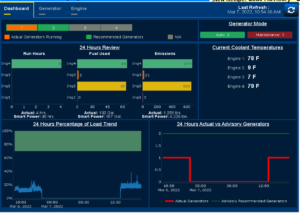
AI-based systems
In December 2021, Nabors launched Nabors Energy Transition Solutions (NETS), a portfolio of technologies designed to improve energy efficiency, reduce fuel consumption and lower emissions. At the heart of this portfolio is the SmartPOWER Advisory and Controls engine management software. The advisory system, which is deployable to Nabors and third-party rigs, applies artificial intelligence (AI)-based algorithms to real-time drilling data, advising the driller on the optimal number of engines to run for a given task in a drilling operation. The SmartPOWER Control system, which is expected to launch in Q2 2022, automates the start and stop of the individual rig engines based on those advisories.
James Hall, Product Line Director at Canrig Drilling Technology, a Nabors subsidiary, said the software is unique in its ability to incorporate numerous external factors in its advisory mechanism. SmartPOWER focuses on the true drilling data received through the electronic drilling recorder (EDR) and uses proprietary AI to recommend the optimal number of engines and generators to run, both for current and predicted drilling activity.
In addition to real-time drilling data, a separate module within the system accounts for altitude, coolant temperature, oil condition and filter condition within the engine to further optimize decision making. The system also accounts for an engine’s service life and maximum capacity.
“Our system evaluates engine condition and other factors to determine which engines have the highest capacity,” Mr Hall said. “It’s just as important to know which engines to run as it is to know how many engines to run.”
Field testing of the advisory system, carried out on a Nabors rig in Q1 2022, indicated a reduction in diesel consumption in line with internal models showing up to 20% in certain applications, with an equivalent reduction in CO2 emissions. This reduction is with respect to the baseline set from average fuel consumed during operations running all available engines, with no manual intervention of the generators.
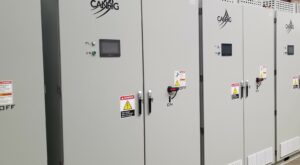
In Q2 2022, Nabors plans to release a super-capacitor energy storage system, Canrig PowerFLOW. Similar in function to other energy storage systems, PowerFLOW uses super-capacitors to provide immediate power for load spikes during tripping and other operations, maximizing energy capture during drawworks braking and reducing the need for diesel-generated power above baseload.
The difference between super-capacitor and battery energy storage is the super-capacitor’s ability to near instantaneously store provided power and its speed at supplying power back to the system. The PowerFLOW’s charge/discharge rate (C rating) ranges from 25 to 50 C, meaning that it can provide 3,500 amps of power in just over a minute, and the system can support 1,000-amp discharge for 9.5 minutes. A battery energy storage system’s C rating typically ranges from 3 to 5 C, meaning that it can discharge a maximum of 1,500 amps for up to 12 minutes at max capacity.
A higher C rating means that a system can deliver more power to the system at faster speeds, which is valuable for tasks with high power demand. It also means that the system can recharge faster, with recharge times in the range of 1 to 6 seconds, depending on drilling activities. Due to the fast recharge characteristics of PowerFLOW, the system is capable of fully charging from “free” regenerative power, rather than drawing charge from the generators. This capability makes it easier for users to maintain peak shaving, avoiding the spikes in power demand that can drive up diesel usage and, subsequently, emissions.
An additional feature available when combining SmartPOWER and PowerFLOW is the ability for the super-capacitor power to be pushed to the AC bus. AC bus frequency can be monitored, and PowerFLOW can inject AC voltage to the AC bus if frequency drops, when either large AC or DC loads are felt on the AC bus. This ensures that the generators maintain constant load and, therefore, no engine surges occur during any operation.
“Imagine a system that you can fill up with power and discharge quickly. That’s where super-capacitors have value,” Mr Hall said. “By using these super-capacitors, you can monitor and control the discharge rates. For our drilling operations, energy storage isn’t really about powering the rig when your other sources of power are removed; it’s about giving you the ability to be more efficient with power generation. You’re using the super-capacitor to supplement that power generation, and you can run your engines at a constant load, even though you have these high demand peaks.”
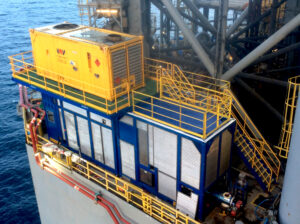
Eliminating drill cuttings waste transport
NOV’s recent low-carbon technology offerings have targeted mitigating, or outright eliminating, wasteful activities in a drilling operation. One area of focus for the company is on the treatment of oil-based drilling waste. Last year, the company launched its iNOVaTHERM portable treatment unit to allow companies to treat and dispose of drilling waste on the rig, as opposed to the conventional process of shipping the waste to shore for treatment and disposal, eliminating a notable source of emissions from a drilling operation.
The system works by feeding drilling cuttings into a feed hopper. Those cuttings are then transferred to a heat exchanger module for treatment. Inside the heat exchanger module, the drill cuttings remain in constant contact with the heated internal surface area to ensure that consistent results on waste separation is achieved.
A condensation module recovers the heavier phase of the oil, which is then returned to the mud system. The steam condensation within the condensation module is then transported to a water treatment module, which recovers the lighter phase of oil. The recovered water is then discharged from the rig.
The iNOVaTHERM system eliminates the drive module found in a conventional frictionally heated waste-processing system, with the power going directly into the high-efficiency heat exchanger. Gordon Duthie, Senior Director of Sales – Eastern Hemisphere at NOV, said this feature reduces the footprint and helps conserve power and emissions on the rig, since the rig does not need to supply power to the gearbox, rotor and hammers found in typical friction-based systems.
However, the biggest savings with emissions comes from eliminating the supply vessels typically used to transport cuttings waste from the rig site to the shore, and the trucks needed to transport the cuttings waste from the vessel to the onshore treatment facility.
“The treatment at the source really eliminates many of the logistical challenges that come from operating in a remote location, whether that’s on land or offshore. Any conventional waste handling requires you to use a supply vessel to go out to the rig and take back the containers of cuttings. From a carbon footprint reduction standpoint, this system eliminates the need for all that activity, and we’re eliminating the need for onshore processing and disposal in a land fill,” Mr Duthie said.
The numbers from NOV’s project scenario data illustrate the emissions savings that are possible from utilizing the system on the rig site. Comparing the emissions generated against conventional containment and waste-processing methods, iNOVa-THERM eliminates the supply vessels used offshore and the trucks used onshore to transport the waste to the treatment facility, as well as the onshore treatment and disposal operations. In this project scenario, a significant amount in emissions (280,264 kg of CO2 per drilling campaign) was saved by treating the drilling wastes on site. Overall, the conventional method created 319,063 kg of CO2 emissions and 4,720 kg of NOx emissions. With the iNOVaTHERM system, those figures went down to 186,436 kg of CO2 and 3,107 kg of NOx.
“These numbers demonstrate that processing drilling wastes offshore goes a long way towards meeting the emission reduction goals and targets our clients have committed to. Once we start eliminating the supply vessel and the other logistics with onshore processing, there are significant environmental and cost savings to be had,” Mr Duthie said.
The technology was launched commercially in January 2021 in the UK sector of the North Sea following 18 months of development and testing at NOV’s thermal treatment plant in Aberdeen. It has since been used by two major oil and gas operators on four drilling campaigns in the North Sea. A fourth campaign began in April 2022.
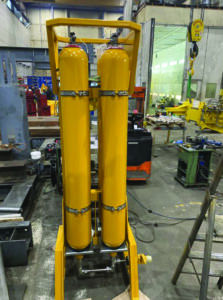
Boosting hydraulic pump efficiency
Another erratic power consumer on the rig is the hydraulic ring line. This system feeds several pieces of hydraulic equipment on the rig, including iron roughnecks, power casing tongs, vertical column pipe rackers and catwalk machines. The flow and pressure in the ring line system are usually set to a level that can accommodate simultaneous operation of these pieces of equipment.
Richard Verhoef, Product Line Manager for Handling Tools at NOV, compared the hydraulic pumps powering the ring line system to generator sets. To deal with the potential hydraulic demands at peak usage, more pumps are running than what is really needed for a large percentage of the time. Pumps running idle for 24 hours a day consume a large amount of electricity and fuel, continuously emitting CO2 and NOx. However, the pumps need to be able to handle sudden increases in flow requirements when the hydraulic pump is activated. Hydraulic equipment already in operation will also be affected by this pressure drop.
To help operators use their hydraulic pumps more efficiently, thereby reducing power usage and emissions, NOV launched its Eco Booster system last year. Eco Booster is a hydraulic energy storage system that optimizes hydraulic ring line performance by storing hydraulic power when demand is low and releasing hydraulic power when demand is high. When additional flow is required, the technology transfers hydraulic energy from the accumulators, limiting the need for additional hydraulic pumps to start up.
“This system basically eliminates that pressure drop. Instead of having the pumps increase their RPM to boost the pressure in the system, Eco Booster provides that short peak of hydraulic power. Instead of having all of your pumps running all of the time, you can reduce the number of motors and pumps that are running. That’s where the power usage savings come from. That’s where the emissions savings come from,” Mr Verhoef said.
The technology is made up of an accumulator skid with four nitrogen pre-charged accumulators, a booster skid and an automated control system. The accumulator is charged by a pressure booster when the ring line flow consumption is low.
When charged, the accumulator matches the flow requirements and demands of the equipment, even when those requirements and demands exceed the ring line pump’s capacity. The accumulator also stores power during periods of light loading on the hydraulic equipment – a process known as load leveling – leading to more optimal use of the hydraulic pumps. The Eco Booster also dampens the variations caused by sudden power demands, providing instant flow and pressure to the ring line.
NOV estimated the savings it could generate from the Eco Booster based on historical power usage data. A rig typically runs six hydraulic pumps 24 hours a day, with each pump consuming 55 kW of power each day. Each pump burns an average of 0.2875 liter/kW used, and NOV calculated 3.23 kg of CO2 and 4.2 g of NOx emitted for every liter of fuel burned on the rig.
With the Eco Booster system installed, a rig can potentially run on four generators 65% of the time it is in operation. Over the course of an entire year, this would mean annual fuel savings of 180,072 liters. Emissions-wise, that annual fuel savings would lead to 581 tons of CO2 saved and 756 kg of NOx savings per year.
Some countries already impose taxes on CO2 and NOx emissions, resulting in an even higher operational cost to the rigs operating in those areas. Even if the system is used in an area without emissions taxes, Mr Verhoef noted that operators can make up the cost of installation in a few years. “If you’re saving tens of thousands a year in fuel costs, this system becomes a relatively small investment for the customer with a pretty good return on investment. The more pumps you can put offline, the better the savings, and the more stable the hydraulic system is, the better you are with emissions.”
Since its commercial launch in 2021, the Eco Booster system has been installed on one rig for a major operator in the North Sea. Mr Verhoef said NOV has commitments to install four additional units for separate operators later this year. DC




